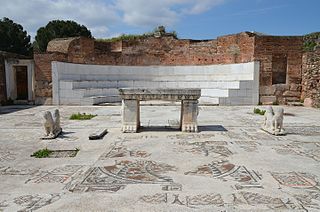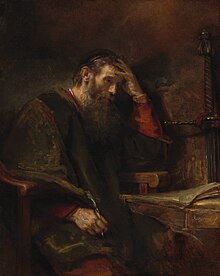
The brit milah or bris is the ceremony of circumcision in Judaism. According to the Book of Genesis, God commanded the biblical patriarch Abraham to be circumcised, an act to be followed by his male descendants on the eighth day of life, symbolizing the covenant between God and the Jewish people. Today, it is generally performed by a mohel on the eighth day after the infant's birth and is followed by a celebratory meal known as seudat mitzvah.

The Epistle to the Galatians is the ninth book of the New Testament. It is a letter from Paul the Apostle to a number of Early Christian communities in Galatia. Scholars have suggested that this is either the Roman province of Galatia in southern Anatolia, or a large region defined by Galatians, an ethnic group of Celtic people in central Anatolia.

Paul, commonly known as Paul the Apostle and Saint Paul, was a Christian apostle who spread the teachings of Jesus in the first-century world. Generally regarded as one of the most important figures of the Apostolic Age, he founded several Christian communities in Asia Minor and Europe from the mid-40s to the mid-50s AD.

Supersessionism, also called replacement theology or fulfillment theology, is a Christian theological doctrine which describes the theological conviction that the Christian Church has superseded the nation of Israel assuming their role as God's covenanted people, thus asserting that the New Covenant through Jesus Christ has superseded or replaced the Mosaic covenant exclusive to Jews. Supersessionist theology also holds that the universal Christian Church has replaced ancient Israel as God's true Israel and that Christians have replaced the biological bloodline of ancient Israelites as the people of God.
Antinomianism is any view which rejects laws or legalism and argues against moral, religious or social norms, or is at least considered to do so. The term has both religious and secular meanings.
Religious circumcision generally occurs shortly after birth, during childhood, or around puberty as part of a rite of passage. Circumcision is most prevalent in the religions of Judaism and Islam. Circumcision for religious reasons is most prominently practiced by members of the Jewish and Islamic faiths.

Pauline Christianity or Pauline theology, otherwise referred to as Gentile Christianity, is the theology and form of Christianity which developed from the beliefs and doctrines espoused by the Hellenistic-Jewish Apostle Paul through his writings and those New Testament writings traditionally attributed to him. Paul's beliefs were rooted in the earliest Jewish Christianity, but they deviated from this Jewish Christianity in their emphasis on inclusion of the Gentiles into God's New Covenant and in his rejection of circumcision as an unnecessary token of upholding the Mosaic Law.

The Council of Jerusalem or Apostolic Council is a council described in chapter 15 of the Acts of the Apostles, allegedly held in Jerusalem around c. 48–50 AD.

Jewish Christians were the followers of a Jewish religious sect that emerged in Judea during the late Second Temple period. These Jews believed Jesus to be the prophesied Messiah, but maintained the observance of Jewish law. Jewish Christianity is the foundation of Early Christianity, which later developed into Catholic and Eastern Orthodox Christianity. Christianity started with Jewish eschatological expectations, and it developed into the worship of Jesus as the result of his earthly ministry, his crucifixion, and the post-crucifixion experiences of his followers. Modern scholarship is engaged in an ongoing debate as to the proper designation for Jesus' first followers. Many see the term Jewish Christians as anachronistic given that there is no consensus on the date of the birth of Christianity. Some modern scholars have suggested the designations "Jewish believers in Jesus" or "Jewish followers of Jesus" as better reflecting the original context.
Circumcision likely has ancient roots among several ethnic groups in sub-equatorial Africa, Egypt, and Arabia, though the specific form and extent of circumcision has varied. Ritual male circumcision is known to have been practiced by South Sea Islanders, Aboriginal peoples of Australia, Sumatrans, Incas, Aztecs, Mayans and Ancient Egyptians. Today it is still practiced by Jews, Muslims, Coptic Christians, Ethiopian Orthodox, Eritrean Orthodox, Druze, Samaritans and some tribes in East and Southern Africa, as well as in the United States, South Korea and Philippines.

The Judaizers were a faction of the Jewish Christians, both of Jewish and non-Jewish origins, who regarded the Levitical laws of the Old Testament as still binding on all Christians. They tried to enforce Jewish circumcision upon the Gentile converts to early Christianity and were strenuously opposed and criticized for their behavior by the Apostle Paul, who employed many of his epistles to refute their doctrinal positions.
The biblical term "proselyte" is an anglicization of the Koine Greek term προσήλυτος (proselytos), as used in the Septuagint for "stranger", i.e. a "newcomer to Israel"; a "sojourner in the land", and in the Greek New Testament for a first-century convert to Judaism, generally from Ancient Greek religion. It is a translation of the Biblical Hebrew phrase גר תושב. "Proselyte" also has the more general meaning in English of a new convert to any particular religion or doctrine.

Dual-covenant or two-covenant theology is a school of thought in Christian theology regarding the relevance of the Hebrew Bible, which Christians call the Old Testament.
Early criticism of Judaism and its texts, laws, and practices originated in inter-faith polemics between Christianity and Judaism. Important disputations in the Middle Ages gave rise to widely publicized criticisms. Modern criticisms also reflect the inter-branch Jewish schisms between Orthodox Judaism, Conservative Judaism, and Reform Judaism.
Hellenistic Judaism was a form of Judaism in classical antiquity that combined Jewish religious tradition with elements of Hellenistic culture. Until the early Muslim conquests of the eastern Mediterranean, the main centers of Hellenistic Judaism were Alexandria in Egypt and Antioch in Syria, the two main Greek urban settlements of the Middle East and North Africa, both founded in the end of the fourth century BCE in the wake of the conquests of Alexander the Great. Hellenistic Judaism also existed in Jerusalem during the Second Temple Period, where there was a conflict between Hellenizers and traditionalists.

The Mosaic covenant or Law of Moses – which Christians generally call the "Old Covenant" – played an important role in the origins of Christianity and has occasioned serious dispute and controversy since the beginnings of Christianity: note for example Jesus' teaching of the Law during his Sermon on the Mount and the circumcision controversy in early Christianity.

God-fearers or God-worshippers were a numerous class of Gentile sympathizers to Hellenistic Judaism that existed in the Greco-Roman world, which observed certain Jewish religious rites and traditions without becoming full converts to Judaism. The concept has precedents in the proselytes of the Hebrew Bible.
The incident at Antioch was an Apostolic Age dispute between the apostles Paul and Peter which occurred in the city of Antioch around the middle of the first century. The primary source for the incident is Paul's Epistle to the Galatians 2:11–14. Since the 19th century figure Ferdinand Christian Baur, biblical scholars have found evidence of conflict among the leaders of early Christianity; for example, James D. G. Dunn proposes that Peter was a "bridge-man" between the opposing views of Paul and James, brother of Jesus. The final outcome of the incident remains uncertain, resulting in several Christian views on the Old Covenant.

Paul the Apostle has been placed within Second Temple Judaism by recent scholarship since the 1970s. A main point of departure with older scholarship is the understanding of Second Temple Judaism; the covenant with God and the role of works as a means to either gain or keep the covenant.

Christianity in the 1st century covers the formative history of Christianity from the start of the ministry of Jesus to the death of the last of the Twelve Apostles and is thus also known as the Apostolic Age. Early Christianity developed out of the eschatological ministry of Jesus. Subsequent to Jesus' death, his earliest followers formed an apocalyptic messianic Jewish sect during the late Second Temple period of the 1st century. Initially believing that Jesus' resurrection was the start of the end time, their beliefs soon changed in the expected Second Coming of Jesus and the start of God's Kingdom at a later point in time.


![James the Just, whose judgment was adopted in the Apostolic Decree of Acts 15:19-29, c. 78 AD: "we should write to them [Gentiles] to abstain only from things polluted by idols and from fornication and from whatever has been strangled and from blood..." (NRSV) Saint James the Just.jpg](http://upload.wikimedia.org/wikipedia/commons/thumb/9/96/Saint_James_the_Just.jpg/220px-Saint_James_the_Just.jpg)












